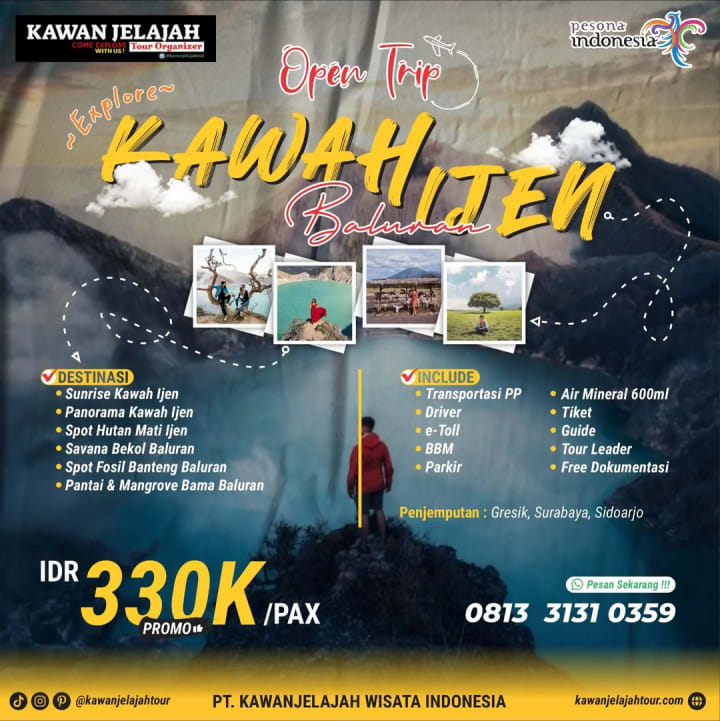Ijen Crater Banyuwangi: The Rare Blue Fire!
Introduction to Kawah Ijen, Banyuwangi The Rare Blue Fire!

Kawah Ijen, Banyuwangi Location and Accessibility
Nestled within the eastern tip of Java, Indonesia, Kawah Ijen is part of the Ijen volcano complex. This prominent geological feature is situated in Banyuwangi Regency, flanked by lush rainforests and dramatic landscapes. The trek to Kawah Ijen begins from the village of Paltuding, a gateway to the volcano. Accessible via a moderately challenging hike, the journey rewards adventurers with breathtaking views and unique geological wonders. The crater itself is a caldera lake known for its turquoise waters, which starkly contrast with the surrounding barren volcanic terrain.
Geological Significance
Kawah Ijen is not just a visual marvel but a site of significant geological interest. It is renowned for its acidic crater lake, the largest of its kind in the world, with pH levels near zero. The lake’s high acidity results from sulfuric gases that emanate from the volcano’s depths, dissolving into the water and creating a hostile environment. The area is also part of the Pacific Ring of Fire, known for its intense seismic and volcanic activity. This complex interplay of geological forces shapes the unique and hazardous environment of Kawah Ijen.
The Mystique of the Blue Fire
The “Blue Fire” of Kawah Ijen is a rare natural occurrence, captivating visitors with its ethereal glow. This phenomenon is produced by the combustion of sulfuric gases that emerge from fissures in the crater. When these gases encounter oxygen in the atmosphere and ignite, they produce a vibrant blue flame, visible in the dark pre-dawn hours. This mesmerizing sight is enhanced by the rugged, moon-like landscape, creating an otherworldly ambiance that draws photographers and adventurers from around the globe.
Scientific Explanation of Blue Fire Kawah Ijen
Scientifically, the blue fire phenomenon is the result of high-temperature sulfuric gases interacting with the surrounding air. These gases, heated to over 600 degrees Celsius, combust upon exposure to oxygen, producing the vivid blue flames. Unlike regular fire, which burns orange or red, the combustion of sulfuric gases emits a blue light due to the specific chemical reaction involved. This rare spectacle can be witnessed in only a few places globally, making Kawah Ijen’s blue fire a natural treasure.
Best Time to Visit Kawah Ijen Banyuwangi
To fully experience Kawah Ijen and its blue fire, timing your visit is crucial. The best time to witness the blue flames is during the dry season, from May to September. During this period, clear skies and minimal rainfall provide optimal viewing conditions. Visitors are advised to begin their ascent around midnight to reach the crater by 2 a.m., ensuring ample time to observe the blue fire before sunrise. This early start also helps avoid the midday heat and crowds.

Visiting Kawah Ijen requires careful preparation due to the challenging terrain and hazardous conditions. Hikers should equip themselves with sturdy footwear, warm clothing, and a gas mask to protect against the sulfur fumes. Guides are recommended for first-time visitors, as they can provide valuable insights and assistance along the trek. Adequate hydration, snacks, and a flashlight are essential for the hike, which can be strenuous and taxing. Additionally, respecting the environment and the local miners is crucial, as their work continues amidst the influx of tourists.
The Impact of Tourism on Kawah Ijen Banyuwangi
Economic Benefits
Tourism has brought significant economic benefits to the region, providing livelihoods for local communities and promoting infrastructure development. The influx of visitors has led to the growth of hospitality businesses, including hotels, restaurants, and tour operators. Local artisans and vendors also benefit from the increased demand for souvenirs and traditional crafts. This economic boost has helped to improve living standards in the surrounding areas, demonstrating the positive impact of responsible tourism on local economies.
Environmental Concerns
However, the rising popularity of Kawah Ijen as a tourist destination has also raised concerns about environmental sustainability. Increased foot traffic and the construction of tourism facilities have led to soil erosion and habitat disruption. The delicate balance of the ecosystem is at risk from littering and pollution, with waste management becoming a pressing issue. Conservation efforts are essential to preserve the natural beauty and ecological integrity of Kawah Ijen, ensuring that future generations can continue to experience its wonders.
The Future of Kawah Ijen
Conservation Initiatives
Efforts to protect and conserve Kawah Ijen are gaining momentum, driven by both local and international stakeholders. Initiatives include reforestation projects to restore native vegetation and programs to reduce the environmental impact of tourism. Education campaigns aim to raise awareness among visitors about the importance of preserving the natural and cultural heritage of the area. Collaborative efforts between government agencies, conservation organizations, and the local community are crucial for the sustainable management of Kawah Ijen.
Balancing Development and Preservation
The future of Kawah Ijen hinges on balancing development with preservation. Sustainable tourism practices are essential to minimize the environmental footprint while maximizing the benefits for local communities. This involves implementing stricter regulations on visitor numbers, improving waste management systems, and promoting eco-friendly practices among tourists and businesses. By fostering a culture of respect and stewardship, it is possible to ensure that Kawah Ijen continues to enchant and inspire while safeguarding its unique natural and cultural legacy.
Conclusion
Kawah Ijen stands as a beacon of natural wonder and cultural richness, its blue fire drawing adventurers from across the globe. From its geological marvels to its historical and cultural significance, the crater offers a multifaceted experience that transcends mere sightseeing. As we marvel at the ethereal glow of the blue flames and traverse the rugged paths etched by sulfur miners, we are reminded of the intricate interplay between nature and humanity. By embracing sustainable practices and respecting the delicate balance of this extraordinary landscape, we can ensure that Kawah Ijen remains a symbol of resilience and wonder for generations to come.
Continue Your Journey! Discover additional insightful articles on our site. Read more here!
About the Creator
Kawanjelajahtour Travel Wisata Bromo Ijen
KawanjelajahTour, berdiri sejak 2017 di Gresik, Jawa Timur, mengkhususkan diri dalam paket perjalanan ke Gunung Bromo, Kawah Ijen, dan destinasi menarik lainnya di Jawa Timur serta Jawa Tengah. Kunjungi Kawanjelajahtour.com
Enjoyed the story? Support the Creator.
Subscribe for free to receive all their stories in your feed. You could also pledge your support or give them a one-off tip, letting them know you appreciate their work.






Comments
There are no comments for this story
Be the first to respond and start the conversation.